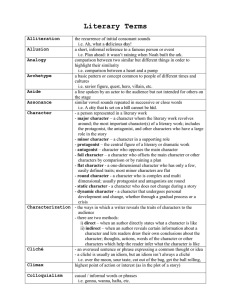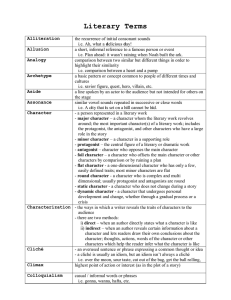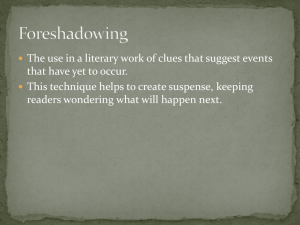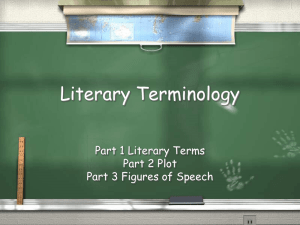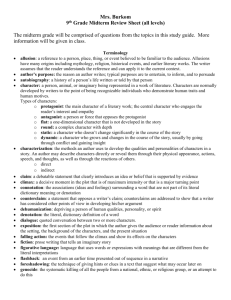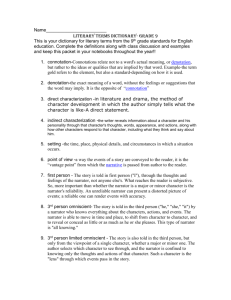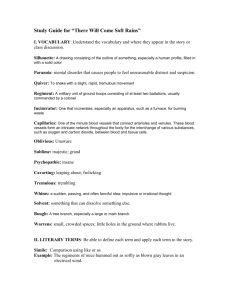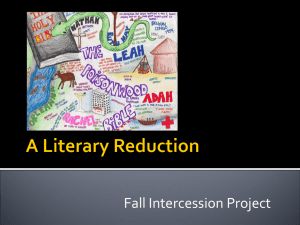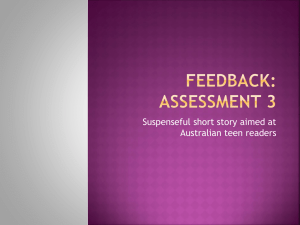LiteraryTerms Definitions
advertisement
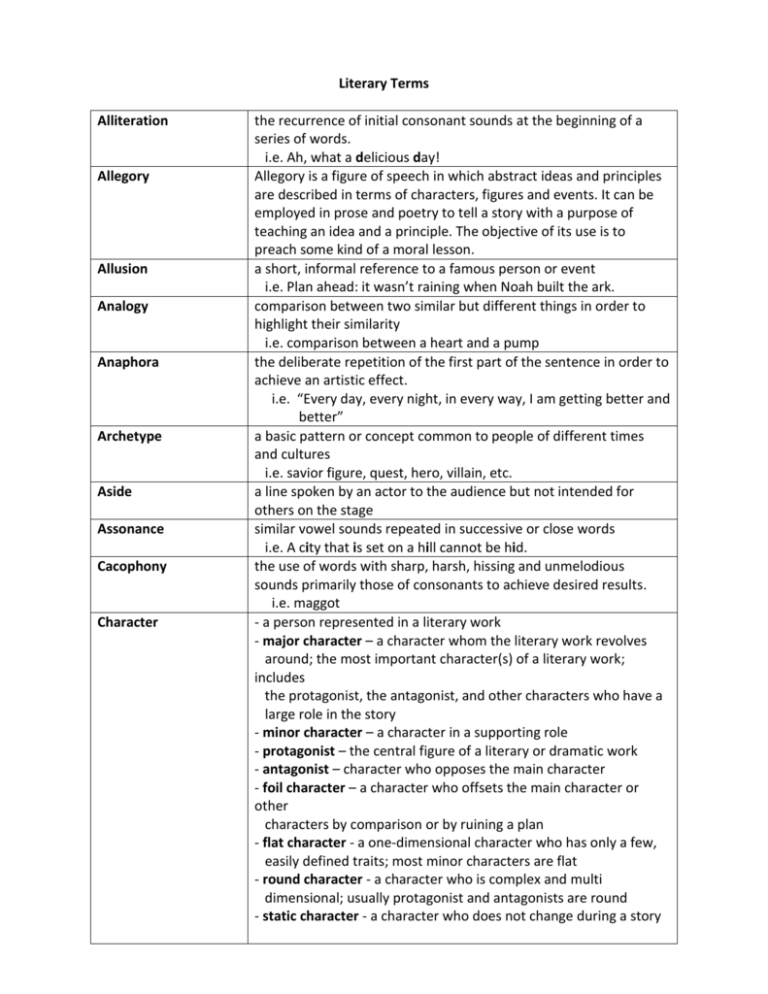
Literary Terms Alliteration Allegory Allusion Analogy Anaphora Archetype Aside Assonance Cacophony Character the recurrence of initial consonant sounds at the beginning of a series of words. i.e. Ah, what a delicious day! Allegory is a figure of speech in which abstract ideas and principles are described in terms of characters, figures and events. It can be employed in prose and poetry to tell a story with a purpose of teaching an idea and a principle. The objective of its use is to preach some kind of a moral lesson. a short, informal reference to a famous person or event i.e. Plan ahead: it wasn’t raining when Noah built the ark. comparison between two similar but different things in order to highlight their similarity i.e. comparison between a heart and a pump the deliberate repetition of the first part of the sentence in order to achieve an artistic effect. i.e. “Every day, every night, in every way, I am getting better and better” a basic pattern or concept common to people of different times and cultures i.e. savior figure, quest, hero, villain, etc. a line spoken by an actor to the audience but not intended for others on the stage similar vowel sounds repeated in successive or close words i.e. A city that is set on a hill cannot be hid. the use of words with sharp, harsh, hissing and unmelodious sounds primarily those of consonants to achieve desired results. i.e. maggot - a person represented in a literary work - major character – a character whom the literary work revolves around; the most important character(s) of a literary work; includes the protagonist, the antagonist, and other characters who have a large role in the story - minor character – a character in a supporting role - protagonist – the central figure of a literary or dramatic work - antagonist – character who opposes the main character - foil character – a character who offsets the main character or other characters by comparison or by ruining a plan - flat character - a one-dimensional character who has only a few, easily defined traits; most minor characters are flat - round character - a character who is complex and multi dimensional; usually protagonist and antagonists are round - static character - a character who does not change during a story Dialogue - dynamic character - a character that undergoes personal development and change, whether through a gradual process or a crisis - the ways in which a writer reveals the traits of characters to the audience - there are two methods: i) direct – when an author directly states what a character is like ii) indirect – when an author reveals certain information about a character and lets readers draw their own conclusions about the character; thoughts, actions, words of the character or other characters which help the reader infer what the character is like - an overused sentence or phrase expressing a common thought or idea - a cliché is usually an idiom, but an idiom isn’t always a cliché i.e. over the moon, sour taste, cat out of the bag, get the ball rolling casual / informal words or phrases i.e. gonna, wanna, hafta, etc. - a struggle between two opposing forces - there are five types: i) person vs. person ii) person vs. self iii) person vs. society iv) person vs. nature v) person vs. fate / supernatural vi) person vs. technology Connotation refers to a meaning that is implied by a word apart from the thing which it describes explicitly. Connotations may be positive or negative depending on the social, cultural and personal experiences of individuals. i.e. If someone is referred to as a “dog”, it connotes shamelessness or ugliness Consonance refers to repetitive sounds produced by consonants within a sentence or phrase i.e. The ship has sailed to the far off shores to compare to show unlikeness or difference to examine and note the similarities between two characters, narratives, things, etc. literal or dictionary meanings of a word in contrast to its connotative or associated meanings. informal language that is culturally based i.e. off the hook, props, etc. the conversation between characters in a drama or narrative Diction Epiphany writer’s choice of words, creates tone, mood, character a sudden moment of realization Characterization Cliché Colloquialism Conflict Connotation Consonance Contrast Compare Denotation Dialect/Slang Euphemism Euphony Fiction Flashback Foil Foreshadowing Genre (comedy, tragedy) Hyperbole Idiom Inference Imagery Irony Juxtaposition an inoffensive or indirect expression that is substituted for one that is considered offensive or too harsh i.e. ‘fatally wounded’ instead of ‘killed’, or ‘held back a grade’ instead of ‘failing a grade’ Pleasant sounding words; the use of words having pleasant and harmonious effects. Generally, the vowels, semi-vowels and the nasal consonants. (ex. Lovely butterfly) a literary work based on imagination and not necessarily on fact a break in the storyline to introduce what has taken place earlier a character that shows qualities that are in contrast with the qualities of another character with the objective to highlight the traits of the other character a hint that something is going to happen before it does categories of literature: - comedy – light and humorous with a happy ending - romance – stories dealing with idealized events, remote of everyday life; stories dealing with love - tragedy – literary work in which the main character is brought to ruin or otherwise suffers extreme consequences of some tragic flaw or weakness of character - satire – literature which generally ridicules the subject intentionally; humour is often used; hyperbole obvious and intentional exaggeration i.e. ‘I’m starving’, ‘waiting forever’, etc. - expressions that cannot be understood literally - a cliché is usually an idiom, but an idiom isn’t always a cliché i.e. kick the bucket, hold a meeting, etc. used commonly in literature and in daily life where logical deductions are made based on premises assumed to be true. descriptive language that evokes a sensory experience i.e. The coach was showered with freezing-cold Gatorade (sight, touch) that ran into his mouth and greeted him with sweetness (sight, touch, taste) - the expression of meaning by using language that normally signifies the opposite - there are three types: i) dramatic – the reader has information that the reader does not ii) verbal – a character says one thing but means another iii) situational – when what happens is the opposite of what is expected to happen is a literary technique in which two or more ideas, places, characters and their actions are placed side by side in a narrative or a poem for the purpose of developing comparisons and contrasts. i.e. “O, she doth teach the torches to burn bright! / It seems she hangs upon the cheek of night” Metaphor Metonymy Mood/Atmosphere Narration Onomatopoeia Oxymoron Paradox Pathetic Fallacy Personification Plot compares two different things by speaking of one in terms of the other i.e. ‘She is a beautiful flower’, ‘I am the bread of life’, etc. a figure of speech that replaces the name of a thing with the name of something else with which it is closely associated. ie. “The White House is concerned about terrorism.” The White House here represents the people who work in it - the prevailing feeling in a story communicated through the author’s direct comments, description of setting, attitudes, actions, imagery - may result in a suspenseful, calm tense mysterious, joyful (etc.) mood/atmosphere the telling of a story; a narrator tells the story, usually a character or the author (see point of view) figure of speech in which words are used to imitate sounds i.e. boom, bang, vroom, hiss, - a figure of speech in which contradictory terms are combined - a paradox reduced to two words i.e. cruel kindness, deafening silence, etc. a statement that contradicts itself i.e. ‘I always lie’ (a paradox because if it is true, it must be false) nature (especially weather) reflects the mood of the story i.e. ‘It was a dark and stormy night’ and the mood of the story is depressing, frightful, etc. when animals, ideas, or objects are given human characteristics i.e. the wind whistled, the chair groaned sequence of events that take place in a narrative: plot graph: 4 5 3 1 Point of View (1st, 2nd, 3rd) 6 2 1) exposition/introduction – introduction to the facts of the narrative 2) trigger incident–one event sets the events of the narrative in motion 3) rising action – a series of incidents (inciting incidents) which cause the reader’s interest to rise; as the suspense grows, the reader is forced to ask questions and discover answers 4) climax – the highest point of action or interest 5) falling action – a series of events that occur after the climax which resolves conflict and explains details 6) conclusion – story is brought to an end, problems are solved - methods of narration - there are four types: i) first person – narrator participates in the action and is recounting the events him/herself (uses “I”) Prose Pun Satire Setting Simile Soliloquy Suspense/ Suspense Techniques Symbol Symbolism Synecdoche Theme Tone ii) third person – narrator does not participate in the action of the story; he/she informs the reader how each character behaves (camera-like) iii) third person omniscient – narrator shows thoughts and feelings of all characters; narrator knows all (God-like) iv) third person limited – the narrator knows the thoughts and feelings of only one character, usually the protagonist the ordinary form of spoken or written language, without metrical structure (as in poetry) a play on words to emphasize a different meaning i.e. I used to be a ballerina but I found it too-too difficult. to exaggerate something to the point of ridicule, with the intent of criticizing vice or folly - the context and environment in which a situation exists - there are five aspects to a narrative’s setting: i) time ii) place iii) weather iv) social atmosphere v) mood/atmosphere compares two different things using ‘like’ or ‘as’ i.e. My love is like a red, red rose. a dramatic convention by means of which a character, alone onstage, speaks his or her thoughts aloud; used to inform the audience about a character’s motivations or thoughts uncertainty or excitement regarding what will happen next -The following techniques create suspense: * short sentences * hyperbole * foreshadowing * vivid verbs * understatement * irony - an object or concrete idea that stands for or represents something else - symbols can be natural, colours, religious, cultural, universal/global, personal, etc. i.e. a heart represents love, a four-leaf clover represents Irish culture the use of symbols in literature to suggest other ideas a part of something represents the whole or it may use a whole to represent a part. ie. The word “suits” refers to businessmen a broad idea in a story, or a message or lesson conveyed by a work; this message is usually about life, society or human nature; themes explore timeless and universal ideas; most themes are implied rather than explicitly stated tone is a literary technique that encompasses the attitudes toward the subject and toward the audience implied in a literary work; tone may be formal, informal, intimate, solemn, sombre, playful, serious, ironic, condescending, or many other possible attitudes. Understatement Voice deliberately expressing an idea as less important than it actually is either for ironic emphasis or for politeness and tact i.e. Tiger Woods has some talent as a golfer. voice is the author’s style; the quality that makes his or her writing unique, and which conveys the author's attitude, personality, and character
